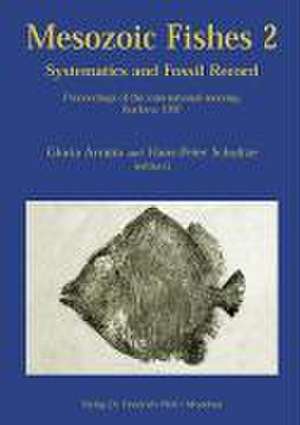Mesozoic Fishes 02. Systematics and Fossil Record
Autor Gloria Arratia, Hans-Peter Schultzeen Limba Engleză Hardback – 1999
Preț: 857.51 lei
Preț vechi: 1113.65 lei
-23% Nou
Puncte Express: 1286
Preț estimativ în valută:
164.14€ • 178.35$ • 137.96£
164.14€ • 178.35$ • 137.96£
Carte indisponibilă temporar
Doresc să fiu notificat când acest titlu va fi disponibil:
Se trimite...
Preluare comenzi: 021 569.72.76
Specificații
ISBN-13: 9783931516482
ISBN-10: 3931516482
Pagini: 604
Ilustrații: 303 Abbildungen, 30 Tabellen, 4 Tafeln
Dimensiuni: 182 x 249 x 42 mm
Greutate: 1.84 kg
Editura: Pfeil, Dr. Friedrich
ISBN-10: 3931516482
Pagini: 604
Ilustrații: 303 Abbildungen, 30 Tabellen, 4 Tafeln
Dimensiuni: 182 x 249 x 42 mm
Greutate: 1.84 kg
Editura: Pfeil, Dr. Friedrich
Notă biografică
The Mesozoic era was an important time in the evolution of chondrichthyan and actinopterygian fishes because it was then that most of the modern groups first entered the fossil record and began to radiate. By the end of the era, many archaic forms had disappeared and the foundation had been laid for the ichthyofauna that now exists. Despite this significant evolutionary change, before 1990 there had been little concerted research done on Mesozoic fishes and no synopsis or compilation of the systematics and paleoecology of Mesozoic fishes had been published, not even for single groups. To remedy this deficiency, Gloria ARRATIA initiated the symposium ¿Mesozoic Fishes¿. The first meeting ¿Mesozoic Fishes - Systematics and Paleoichthyology¿ was held in Eichst¿ from August 9 to 12, 1993 and the first volume of Mesozoic Fishes, including 36 papers concerning elasmobranchs, actinopterygians and sarcopterygians and the paleoecology of certain important fossil localities was published in 1996.Gloria ARRATIA and Hans-Peter SCHULTZE organized the second Symposium. It was held in Buckow, a small village about 45 km east of Berlin, from July 6 to 10, 1997.The results of the symposium presented in this volume reflect the current state of knowledge of Mesozoic fishes. Phylogenetic relationships of chondrichthyans and actinopterygians are the central issue. In addition, attention is given to questions of morphology and to the Mesozoic fossil record in a variety of countries such as southern Asia, Chile, China, Italy, Morocco, Spain, and Switzerland. The new findings described in the 31 papers and the disagreements among authors concerning interpretations of characters and phylogenetic relationships of actinopterygian subgroups are an exciting invitation to further research.
